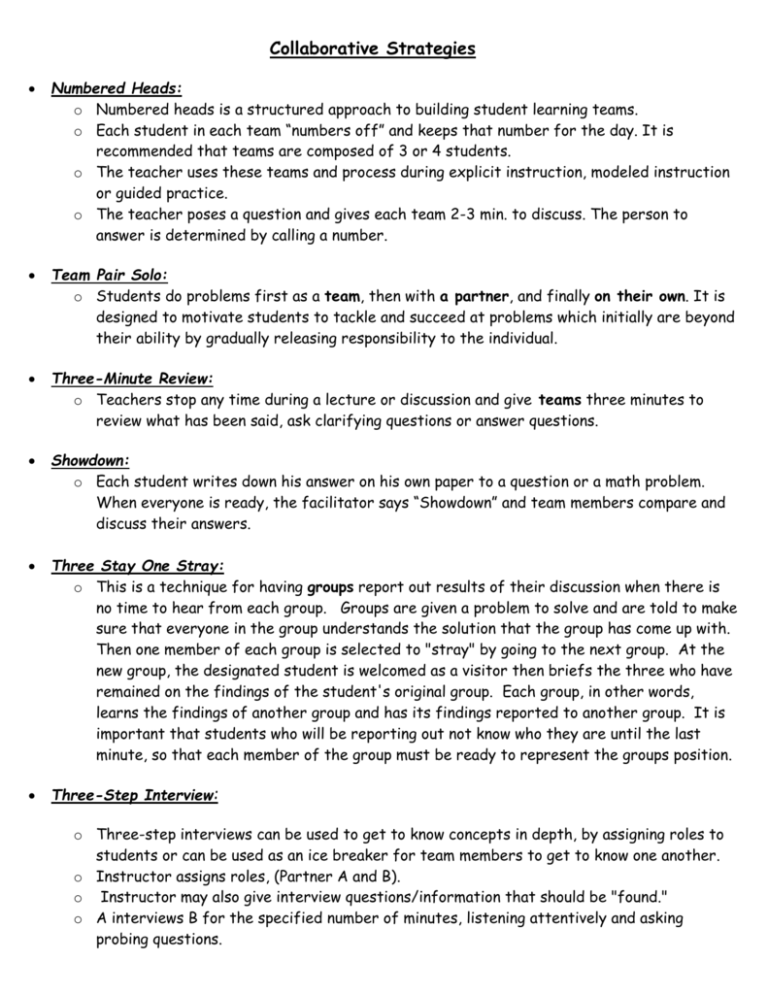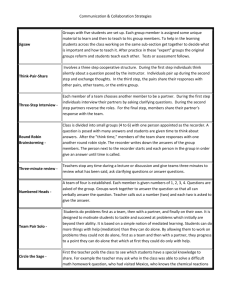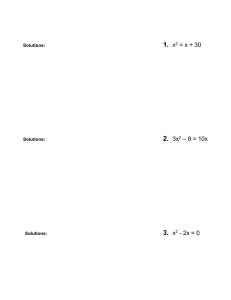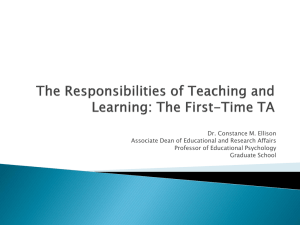Collaborative Strategies Handouts
advertisement

Collaborative Strategies Numbered Heads: o Numbered heads is a structured approach to building student learning teams. o Each student in each team “numbers off” and keeps that number for the day. It is recommended that teams are composed of 3 or 4 students. o The teacher uses these teams and process during explicit instruction, modeled instruction or guided practice. o The teacher poses a question and gives each team 2-3 min. to discuss. The person to answer is determined by calling a number. Team Pair Solo: o Students do problems first as a team, then with a partner, and finally on their own. It is designed to motivate students to tackle and succeed at problems which initially are beyond their ability by gradually releasing responsibility to the individual. Three-Minute Review: o Teachers stop any time during a lecture or discussion and give teams three minutes to review what has been said, ask clarifying questions or answer questions. Showdown: o Each student writes down his answer on his own paper to a question or a math problem. When everyone is ready, the facilitator says “Showdown” and team members compare and discuss their answers. Three Stay One Stray: o This is a technique for having groups report out results of their discussion when there is no time to hear from each group. Groups are given a problem to solve and are told to make sure that everyone in the group understands the solution that the group has come up with. Then one member of each group is selected to "stray" by going to the next group. At the new group, the designated student is welcomed as a visitor then briefs the three who have remained on the findings of the student's original group. Each group, in other words, learns the findings of another group and has its findings reported to another group. It is important that students who will be reporting out not know who they are until the last minute, so that each member of the group must be ready to represent the groups position. Three-Step Interview: o Three-step interviews can be used to get to know concepts in depth, by assigning roles to students or can be used as an ice breaker for team members to get to know one another. o Instructor assigns roles, (Partner A and B). o Instructor may also give interview questions/information that should be "found." o A interviews B for the specified number of minutes, listening attentively and asking probing questions. o At a signal, students reverse roles and B interviews A for the same number of minutes. o At another signal, each pair turns to another pair, forming a group of four. Each member of the group introduces his or her partner, highlighting the most interesting points. Talking o Find the Fib: o Students write down two facts and one fib, the job of the team is to identify the fib. This can be used as a team building activity or as a way to review for a test. Circle o Chips: Each student in the group is given an equal amount of chips and each time they talk they must submit a chip. Once their chips are gone they may no longer talk. All students are required to use their chips. the Sage: First the teacher polls the class to see which students have a special knowledge to share. For example the teacher may ask who in the class was able to solve a difficult math homework question, who had visited Mexico, who knows the chemical reactions involved in how salting the streets help dissipate snow. Those students (the sages) stand and spread out in the room. The teacher then has the rest of the classmates each surround a sage, with no two members of the same team going to the same sage. The sage explains what they know while the classmates listen, ask questions, and take notes. All students then return to their teams. Each in turn, explains what they learned. Because each one has gone to a different sage, they compare notes. If there is disagreement, they stand up as a team. Finally, the disagreements are aired and resolved. Gallery Walk: o A Gallery Walk requires a report-out of group learning that can be visually depicted, preferably on butcher paper. It can be an outline, a concept or mind map, or any other written product. In this case a designated student stays by the desk or table or next to the butcher paper if it is taped to the wall and serves as the group spokesperson. The other students rotate around the room examining the products of other teams' thinking, asking questions of the designated spokesperson. (The spokesperson role should be rotated so that no one is left without the stimulation of exploring the different student creations.) o This structure is also efficient and engenders a sense of team cohesion as each group displays the product of their "group think." The variety of the end products emphasizes the value of critical/creative thinking. o You can use a variation of "Gallery Walk" when you have required individual or team longterm products. Rather than having time-consuming report-puts, each student circulates to classmates a summary of his or her project. Each product, such as a term paper or student portfolio, is assigned to specific work area, as in a conference poster session. Then a class period can be spent with students examining one another’s work. To provide an opportunity for feedback, each student leaves a comment sheet next to the product, and browsers write a brief response. Fishbowl: o Teams of three or four work on a problem or exercise. At the same time, other teams of three or four observe the first teams. In particular, the first teams work on seeking other points-of-view, listening to and paraphrasing ideas, and other communication skills while solving the given problem. The second teams focus their attention on the team dynamic and make sure they are prepared to discuss how well or poorly the first teams worked together to solve the problem. (There is sometimes the tendency of the second teams to focus on the problem rather than the team dynamic.) After some time (even if every team has not finished the problem), the class discusses what happened and what didn't happen during the activity. Teams o Check: Teammates help each other understand answers to exercises, so that any member of the team may be called upon to answer any one of the questions. Jigsaw: o If there is reading material (such as background) to be digested before doing an activity, split it up into 3 or 4 self-contained parts. Divide the class into the same number of Reading Groups (one group for each section), with one member from each team. Give one part of the reading to each team to digest and to prepare to explain to their team. Then rearrange the students so that each team has someone who has read one of the selfcontained parts, and have each student teach his/her part of the reading to the rest of the team. Teammate Consult: o Students all have their own copy or the same worksheet or assignment questions. o A cup is placed in the center of each team and students begin by placing their pen in the cup. o With pens still in the cup, they discuss their answers to the first question. When all team members are ready, they remove their pens from the cup and record their answers without talking. o Repeat this process until all questions are answered. Mix Pair Freeze: o Each student is given a question, vocabulary word, or statement and must walk around the room until the signal is given to stop (could be music, hand signal). o Then student have their partner explain their question and vice versa. o Student can then switch questions and the process is repeated. Team o o o Product or Structured Learning Team Group Roles: Students work together, but each has a primary role. Typical roles are: Manager/Leader (to keep the team on task); Reader (to read aloud the question being answered by the team); o o o o o o Encourager (to make sure everyone participates); Checker (to make sure everyone understands); Writer/Recorder (to record results and to make sure everyone agrees); Artist (if needed to prepare the presentation); and Presenter/Reporter (if needed to explain the team's answer to the rest of the class). The most important roles are the Manager, Checker, and Writer. (In other words, teams of three with these three roles are the most common.) In order to accommodate some of the other roles, students may take on two of them at the same time. Blackboard o Roving o Share: Teams share their answers on with the class and get feedback. This can be done on poster boards or transparencies instead. Reporter. When a team gets stuck, one member is allowed to roam the room looking for ideas and reports back to the team. Two-Box (or Two-Column) Induction: o The teacher puts items into one of two boxes (usually on the blackboard) without telling students what the criteria are for sorting the items. As the teacher adds items to the two boxes, students (standing in teams) discuss the items and possible categories. When a team decides that they know how the sort was done, they sit down without revealing their answer. (This is a non-disruptive way of letting the teacher know how the individual teams are doing.) When all teams are seated, there are three different options: o Ask each team to add an item to each box, and let the other teams evaluate and comment on the choices; o Present additional items to the class, and ask teams to decide which box each item belongs in. o Have teams describe their categories. Rally Table or Roundtable: o Roundtable structures can be used to brainstorm ideas and to generate a large number of responses to a single question or a group of questions. o Teacher poses question. o One piece of paper and pen per group. o First student writes one response, and says it out loud. o First student passes paper to the left, second student writes response, etc. o Continues around group until time elapses. o Students may say "pass" at any time. o Group stops when time is called. o The key here is the question or the problem you've asked the students to consider. It has to be one that has the potential for a number of different "right" answers. Relate the question to the course unit, but keep it simple so every student can have some input. o Once time is called, determine what you want to have the students do with the lists...they may want to discuss the multitude of answers or solutions or they may want to share the lists with the entire class. o Variation: Round Robin Brainstorming: Class is divided into small groups (4-6) with one person appointed as the recorder. A question is posed with many answers. After the "think time," members of the team share responses with one another round robin style. The recorder writes down the answers of the members. The person next to the recorder starts and each person in the group in order gives an answer until time is called. Focused Listing: o Focused listing is used as a brainstorming technique or as a technique to generate descriptions and definitions for concepts. Focused listing asks the students to generate words to define or describe something. Once students have completed this activity, you can use these lists to facilitate group and class discussion. o Example: Ask students to list 5-7 words or phrases that describe or define what a motivated student does. From there, you might ask students to get together in small groups to discuss the lists, or to select the one that they can all agree on. Combine this technique with a number of the other techniques and you can have a powerful cooperative learning structure. Structured Problem-Solving: o Structured problem-solving can be used in conjunction with several other cooperative learning structures. o Have the participants brainstorm or select a problem for them to consider. o Assign numbers to members of each group (or use playing cards). Have each member of the group be a different number or suit. o Discuss task as group. o Each participant should be prepared to respond. Each member of the group needs to understand the response well enough to give the response with no help from the other members of the group. o Ask an individual from each group to respond. Call on the individual by number (or suit). One Minute Papers: o Ask students to comment on the following questions. Give them one minute and time them. This activity focuses them on the content and can also provide feedback to you as a teacher. o What was the most important or useful thing you learned today? o What two important questions do you still have; what remains unclear? o What would you like to know more about? o You can use these one minute papers to begin the next day's discussion, to facilitate discussion within a group, or to provide you with feedback on where the student is in his or her understanding of the material. Send-A-Problem: o Send-A-Problem can be used as a way to get groups to discuss and review material, or potential solutions to problems related to content information. 1. Each member of a group generates a problem and writes it down on a card. Each member of the group then asks the question to other members. 2. If the question can be answered and all members of the group agree on the answer, then that answer is written on the back of the card. If there is no consensus on the answer, the question is revised so that an answer can be agreed upon. 3. The group puts a Q on the side of the card with the question on it, and an A on the side of the card with an answer on it. 4. Each group sends its question cards to another group. 5. Each group member takes ones question from the stack of questions and reads one question at a time to the group. After reading the first question, the group discusses it. If the group agrees on the answer, they turn the card over to see if they agree with the first group's answer. If there again is consensus, they proceed to the next question. If they do not agree with the first group's answer, the second group writes their answer on the back of the card as an alternative answer. 6. The second group reviews and answers each question in the stack of cards, repeating the procedure outlined above. 7. The question cards can be sent to a third, fourth, or fifth group, if desired. 8. Stacks of cards are then sent back to the originating group. The sending group can then discuss and clarify any question Variation: A variation on the send a problem is to use the process to get groups to discuss a real problem for which there may be no one set answer. 1. Groups decide on one problem they will consider. It is best if each group considers a different problem. 2. The same process is used, with the first group brainstorming solutions to a single problem. The problem is written on a piece of paper and attached to the outside of a folder. The solutions are listed and enclosed inside the folder. 3. The folder is then passed to the next group. Each group brainstorms for 3-5 minutes on the problems they receive without reading the previous group's work and then place their solutions inside the folders. 4. This process may continue to one or more groups. The last group reviews all the solutions posed by all of the previous groups and develops a prioritized list of possible solutions. This list is then presented to the group. Value Line: o One way to form heterogeneous groups is to use a value line. 1. Present an issue or topic to the group and ask each member to determine how they feel about the issue (could use a 1-10 scale; 1 being strong agreement, 10 being strong disagreement). 2. Form a rank-ordered line and number the participants from 1 up (from strong agreement to strong disagreement, for example). 3. Form your groups of four by pulling one person from each end of the value line and two people from the middle of the group (for example, if you had 20 people, one group might consist of persons 1, 10, 11, 20). Uncommon Commonalities: Uncommon Commonalities can be used to foster a more cohesive group as a team building activity Groups get together and first list individual things about themselves that define them as people). Groups then discussed each item, finding things that 1, 2, 3, or 4 of them have in common. When the group finds an item that all of them have in common, they list that item under 4; when they find something that 3 of them have in common, the list that item under 3, etc. Guided Reciprocal Peer Questioning: o The goal of this activity is to generate discussion among student groups about a specific topic or content area. o Instructor conducts a brief (10-15 minutes) lecture on a topic or content area. Instructor may assign a reading or written assignment as well. o Instructor then gives the students a set of generic question stems. o Students work individually to write their questions based on the material being covered. o Students do not have to be able to answer the questions they pose. This activity is designed to force students to think about ideas relevant to the content area. o Students should use as many question stems as possible. o Grouped into learning teams, each student offers a question for discussion, using the different stems. Sample question stems: What if...? What is the main idea of? How does...affect...? What is a new example of...? Explain why...? Explain how...? How does this relate to what I've learned before? What conclusions can I draw about...? What is the difference between... and...? How are...and...similar? How would I use...to...? What are the strengths and weaknesses of...? What is the best...and why? Sage-N-Scribe: o Partners work together to understand text, notes, teacher-led discussions. o One student, the SAGE, states/shares what they know, the other student, the SCRIBE records. The SCRIBE student coaches the other student and can provide learning clues to them by asking probing questions but must record only what is said. o After the Scribe has recorded all that the Sage has said, select a Scribe to report out to the class. Clock Buddies: o Clock Buddies is meant to be a quick and easy way to create pairs for partnered activities to avoid students working with the same partners. It begins with a clock face, with slots for names extending from each hour on the dial (or you can modify with a 3, 6. 9, and 12 o’clock slots on the clock face. The basic idea is that each student has his or her own copy of a Clock Buddies sheet, with the names of 12 classmates (or 4 if modified) on each hour's slot. Each of those other students, in turn, has this student's name in the matching hour slot on each of their clock sheets. Allow 30-60 seconds for students to make their “appointments”. Directions for Clock Buddies might sound like: “Tell your 6:00 partner____________. Review answers with you 12:00 partner. Compare ___________ with your 3:00 partner. “ Inside-Outside Circles: o During inside-outside circle, students either sit or stand facing each other in two concentric circles. Inside circle will rotate, outside circle is stationary. o Students respond to teacher questions or note-card prompted questions and then rotate to the next partner. o In the end of this type of structure, students will have both been teachers and learners of new information. o This structure also facilitates peer tutoring and checking for different levels of knowledge acquisition. o Double Entry Journal: o The Double Entry Journal can be used as a way for students to take notes on articles and other resources they read in preparation for class discussion. o Students read and reflect on the assigned reading(s). o Students prepare the double entry journal, listing critical points of the readings (as they see them) and any responses to the readings, in general, or specific critical points. o Students bring their journal notes to class o Once in class, students may use their double entry journal to begin discussion, to do a paired annotation, or for other classroom and group activity. Pairs Check: o Teams of four work in pairs on a set of exercises. First one member works on a problem, while the second member coaches. Then the second member works on a problem while the first coaches. Pairs then check their answers with members of the same team. After all problems, inconsistencies, etc. are resolved; the process is repeated for subsequent exercises. Pairs Check II: o This is the same as Pairs Check, except that students do exercises individually beforehand. One student explains his/her answer on a question to another student, and they discuss it. Then, they reverse roles for the next question. Answers are agreed upon before sharing with the whole team. Think-Pair-Share: o Students think about each question, pair off and discuss the question with a classmate, and share their answers with the class. Think-Pair-Square: o This is the same as Think-Pair-Share, except that students share their answers with members of another pair. Paired Annotations: o Students pair up to review/learn same article, chapter or content area and exchange o o double-entry journals (see below) for reading and reflection. Students discuss key points and look for divergent and convergent thinking and ideas. Together students prepare a composite annotation that summarizes the article, chapter, or concept. Webbing: Students, as a team or individually, construct a concept map within a specified domain, open-ended or with concepts provided by the teacher. If done in teams, member should have a different color of pen. each Word o Structured Academic Controversies: o To start, the instructor selects a topic with two different viewpoints (e.g., "Nuclear energy should be used more/less in this country."). Students form groups and divide into two pairs. Each pair is assigned an advocacy position, and depending on available time, either receives supporting documentation or researches the topic. If the instructor wishes, student pairs from different groups with the same positions can compare ideas after becoming familiar with their positions. The student pairs highlight the main arguments for their position and prepare a short presentation. o Each student pair then presents their position to the other pair in their group. The students listen and take thorough notes but are not permitted to ask questions, disagree, or debate. After the presentation, the other pair presents their position. After the presentations, the students discuss their positions and provide more supporting evidence. With their notes as a guide, the students switch advocacy positions and prepare and give a new presentation. Finally, students drop their advocacy role and generate a consensus report addressing the original question posed (Johnson, et al. 1991). o Academic controversy can enhance student skills including: researching issues organizing information preparing/advocating a position being able to rationalize one's position learning to debate evaluating strengths and weaknesses on both sides of an issue seeing issues from other perspectives re-conceptualizing one's position synthesizing information reaching consensus






